Unprecedented labor shortages continue to weigh down the U.S. economy, resulting in higher food prices, cancelled flights, delayed deliveries, reduced public safety, and overcrowded emergency rooms. This Backgrounder examines the current U.S. labor market by diving deeper into the employment trends among different groups of workers with data through May 2022.REF In contrast to the first two Backgrounders in this employment-trends series, this update includes additional analysis of age-based differences and an updated methodology that is better suited for analyzing changing populations over time.REF
Total Employment Gap
With 158.4 million employed workers, employment today is 2.9 million (1.8 percent below the pre-pandemic rate). This “employment gap” compares employment since the pandemic to what it would have been had the employment-to-population ratio remained the same as it was in February 2020, with the goal of providing a metric to where employment might have been without the pandemic and absent other economic changes.REF In net terms, not accounting for population growth, employment today is 440,000 (0.3 percent) below its pre-pandemic February 2020 level.
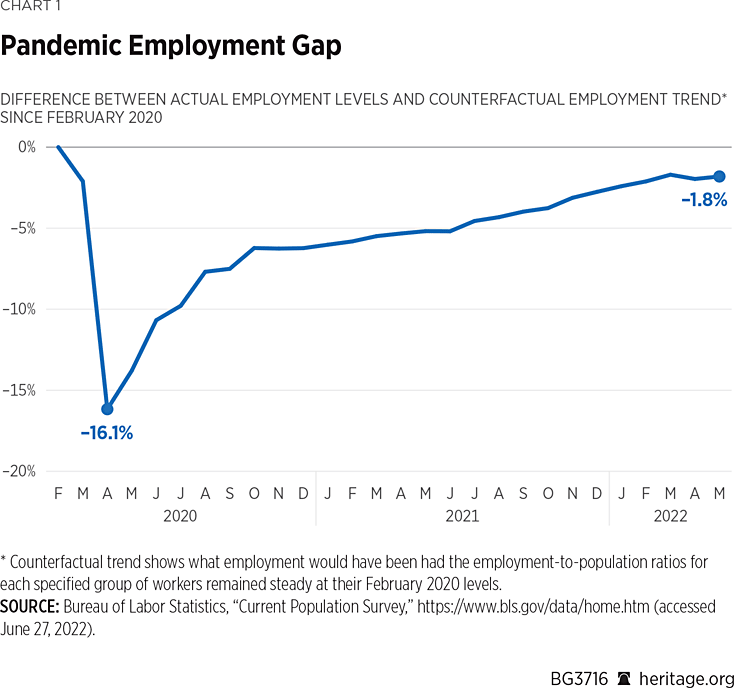
The Labor Shortage
The labor market in the first half of 2022 has arguably never been stronger for workers. The current 11.3 million job openings (May 2022) are 50 percent above the pre-pandemic record high and translate into 1.9 available jobs for every individual who is looking for one.REF The employment gap is simultaneously a supply-and-demand problem. The labor supply is down by about 2.9 million since the start of the pandemic, and on top of that, economists find that a significant decline in the desired hours of work has roughly doubled the magnitude of the labor force decline.REF Economic studies show that 18 months’ worth of widely available $600 weekly unemployment insurance bonuses reduced the labor supply,REF and it appears that expansions of programs that provide welfare benefits without work requirements, such as Supplemental Nutrition Assistance Program (SNAP) benefits and Obamacare subsidies, continue to reduce employment.
As the supply of workers fell, the demand for the goods and services they produce and offer surged as federal spending in 2020 and 2021 was 45 percent higher than in 2019. About half of that increased spending came from money printed by the Federal Reserve. Since early 2020, Federal Reserve assets more than doubled—by nearly $5 trillion—and those new dollars injected into the economy caused a 35 percent increase in the overall money supply since early 2020.REF This surge in demand and reduction in supply created unprecedented labor shortages for employers.
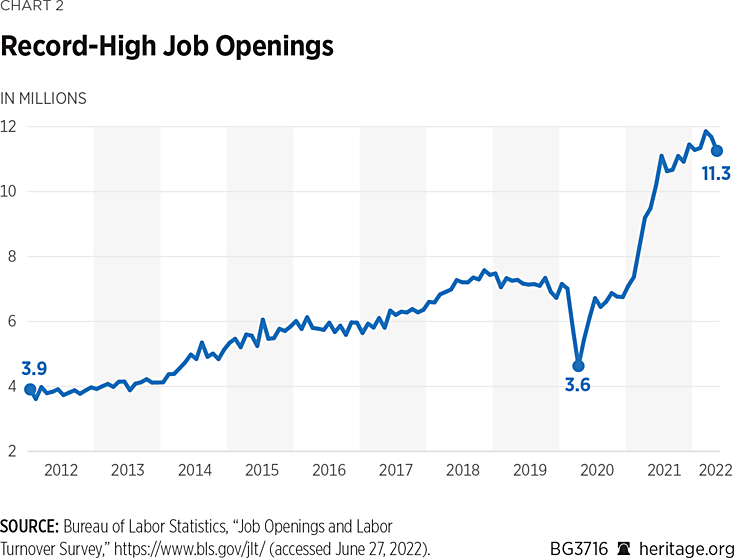
Employers are also struggling amid workers quitting their jobs at record-high rates. Over the past year, 51 million workers—more than one in three—quit their jobs. In 2019, about 42 million workers had quit. That has required employers to replace nearly 9 million more workers over the past year than in the year prior to the pandemic. Replacing workers is costly. The Society for Human Resource Management reports that it costs employers between six and nine months of a worker’s salary to replace him.REF Part of the 75-year record-low productivity level in the first quarter of 2022—a decline of 7.3 percent—was likely due to having to replace and retrain high numbers of workers.
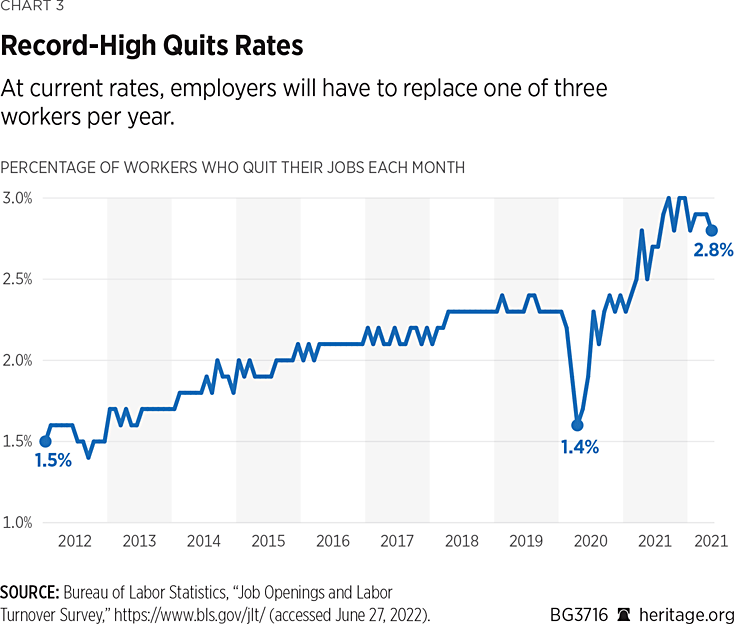
According to the National Federation of Independent Business (NFIB), 67 percent of business owners were trying to hire workers in May 2022, and 92 percent of those seeking to hire reported few or no qualified applicants.REF This left a record-high 51 percent of businesses reporting job openings that they were unable to fill.REF
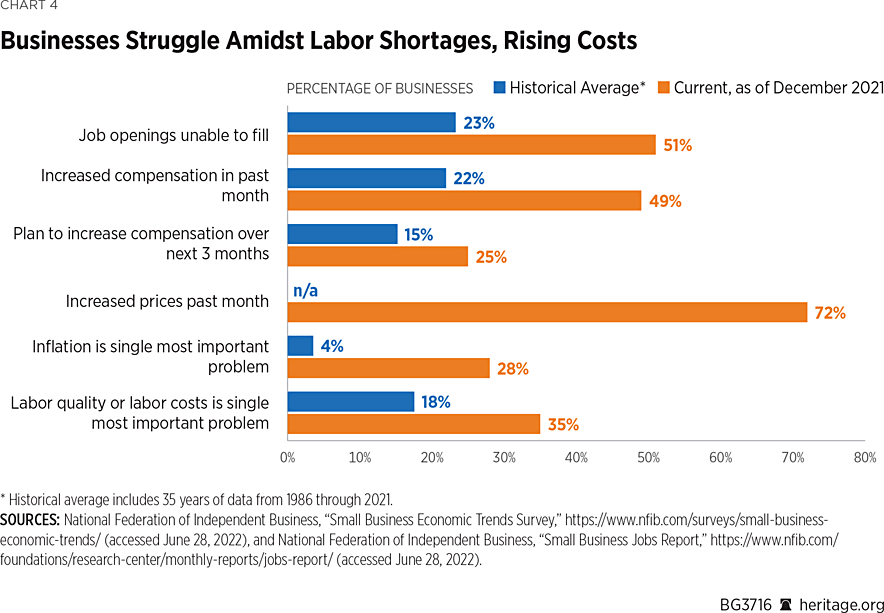
The labor shortage has caused employers to raise compensation, with 49 percent of businesses reporting that they increased compensation in May, and another 25 percent saying that they plan to raise compensation over the next three months (between June and August).REF Compared to earlier reports, it appears that more businesses have increased compensation than previously planned to, but a smaller percentage of companies are planning future compensation increases. This could be due to a slowing economy. The Atlanta Federal Reserve’s GDPNow metric estimates that real GDP declined 1.9 percent in the second quarter of 2022.REF
Although hourly pay increased by an above-average 5.2 percent over the past year (May 2021 to May 2022), real average earnings (taking into account the effect of inflation) were down by 3.0 percent.REF That means that a full-time median worker earned $3,200 more, and yet, was able to buy $1,800 less, as inflation acted as a $5,000 tax.
When employers have to pay workers more to do the same thing, they have to increase prices. As the NFIB’s May report states, “These rising labor costs will be passed on to consumers through higher selling prices which are being raised at a record pace.”REF A record-high 72 percent of business owners reported in May 2022 that they raised prices over the past three months.
The Demographics of the Employment Gaps
Throughout the pandemic, different groups of workers have been affected differently. For example, at the beginning of the pandemic, lower-wage workers and women who were caregivers were more likely to have lost jobs or dropped out of the labor force, and older workers faced greater health concerns from COVID-19 that affected their employment. Those realities have shifted over time and the demographics of today’s workers have experienced significant shifts from the start of the pandemic, as well as from before the pandemic.
This analysis calculates an “employment gap,” which represents the difference between current employment levels for each specified group of individuals (based on the most recent May 2022 data) and what those levels would have been if, absent the pandemic, employment-to-population ratios had remained constant at their February 2020 levels.
Current Employment Gaps Largely an Age-Based Phenomenon
Despite widespread availability of jobs across industries and age groups, and employers’ increasing willingness to train workers, the current employment statistics reveal that today’s labor shortages are heavily concentrated among young workers and older workers. Table 1 provides a breakdown of employment gaps for workers across different age groups.REF
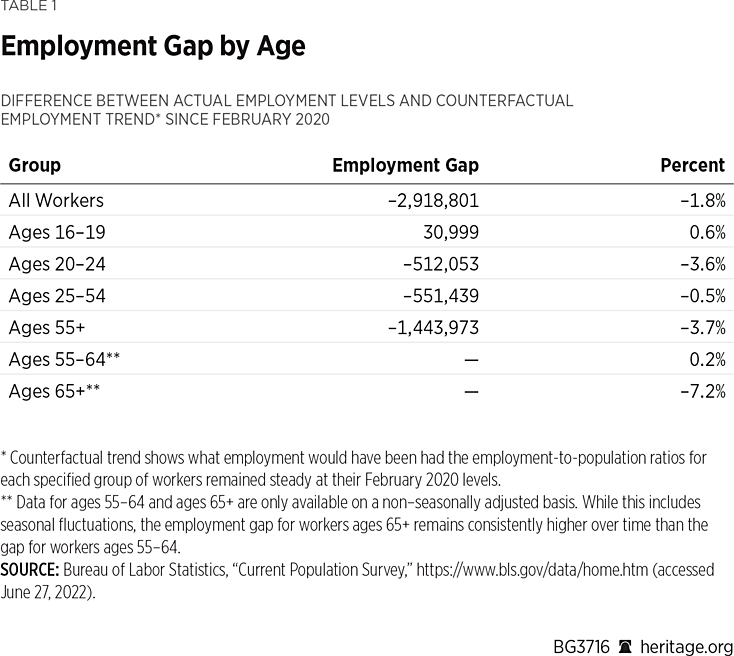
Young workers between the ages of 20 and 24 have a troubling 3.6 percent employment gap, compared to a 0.5 percent gap among workers ages 25 to 54. Teenagers ages 16 to 19 have experienced a full recovery, and their employment is currently 0.6 percent above where it would have been if their employment-to-population ratio were the same as it was in February 2020.
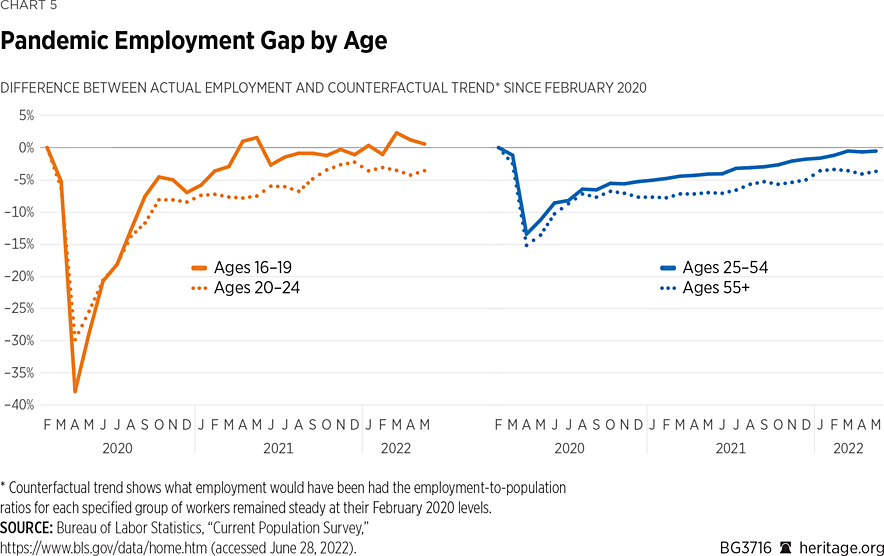
Young Workers’ Employment Declines. One explanation for the 3.6 percent decline in employment among workers ages 20 to 24 could be that more of them are enrolling in higher education, but according to the National Student Clearinghouse Research Center, undergraduate enrollment is down by 9.4 percent from pre-pandemic levels, with the largest decline in community college enrollment.REF The decline in employment and education among workers ages 20 to 24 is particularly troubling considering that these are prime years for launching into the working world, gaining education and experience that can propel careers, and establishing effective work and lifestyle habits and routines.
In addition to ending welfare-without-work programs that can incentivize idleness and dependence over productivity and personal autonomy, policymakers should also look for ways to make it easier for younger individuals to gain education and experience for a successful career without the excessively high costs of a college degree.
In part, that includes phasing out federal subsidies that distort the higher education market by driving up costs at accredited colleges and universities and tilting the scales away from low-cost or no-cost alternatives that often provide more effective and tailored education. For example, employers are already addressing gaps by investing in practical workforce education. When Mazda Toyota Manufacturing established a new plant in Alabama, it taught thousands of new workers about advanced automotive manufacturing techniques to directly meet its workforce needs.REF Bank of America now has a career development Pathways program,REF Walmart launched an education and training Live Better U (LBU) program,REF and Google, Amazon,REF and IBMREF have created their own certificate and training programs based on high-demand skills.REF But federal subsidies for higher education and the Biden Administration’s plans to forgive up to $10,000 worth of student loan debt per borrower signal that a four-year degree is the best, and dissuade individuals from equal or even better forms of education.REF
Apprenticeships have also proven to be a successful alternative to gaining the knowledge and experience necessary for a rewarding career. For roughly 80 years, the government’s Registered Apprenticeship Program (RAP)—which requires conforming to government standards and includes federal funding, tax credits, and other federal resources—has dominated apprenticeship programs in the U.S. While this model has been successful in some occupations, organizations across the political spectrum have noted that the RAP’s overly burdensome requirements has caused it to remain restricted to legacy and historically male-dominated and manual-labor-dominated trades. For example, Isabel Soto of the American Action Forum notes in a 2021 report that while the health care sector accounts for six in 10 of the most rapidly growing occupations, health care apprenticeships only make up 2.5 percent of RAPs.REF Annelies Goger and Chenoah Sinclair of the Brookings Institution argued in a 2021 report that “[a] robust apprenticeship system has the potential to increase earnings and reduce occupational segregation in the labor market.”REF
The Trump Administration expanded apprenticeship programs to align them more closely with industry needs through a new Industry-Recognized Apprenticeship Program (IRAP), which quickly led to the creation of more than 130 IRAPs (along with 27 Standards Recognition Entities to recognize and oversee them). Most of these IRAPs were focused on nursing, which faces tremendous worker shortages.REF Yet, the Biden Administration rescinded the Trump Administration’s executive order that expanded apprenticeship programs and directed the Department of Labor to reverse “industry recognized apprenticeship programs (IRAPs) which threaten to undermine registered apprenticeship programs.”REF Policymakers should revive apprenticeship expansions by passing the Training America’s Workforce Act, which would direct the Department of Labor to bring back the IRAP.REF
The strong labor market and opportunistic environment for employer-led and industry-led education alternatives makes this the ideal time to pursue more effective—and lower-cost or no-cost—alternatives to traditional college.
Older Workers’ Employment Declines. At the other end of the age spectrum, older workers are also experiencing significant employment gaps. The topline, seasonally adjusted data shows a 3.7 percent employment gap for workers ages 55 and older. However, a further breakdown of age groups indicates that the employment gap is almost entirely among workers ages 65 and older. Currently, there is no employment gap among workers ages 55 to 64 as their employment-to-population ratio is now slightly above what it was in February 2020,REF but workers ages 65 and older have a 7.2 percent employment gap. (Data for age breakdowns are only available on a non–seasonally adjusted basis, but they reveal consistent patterns of employment declines concentrated in workers over age 65.)
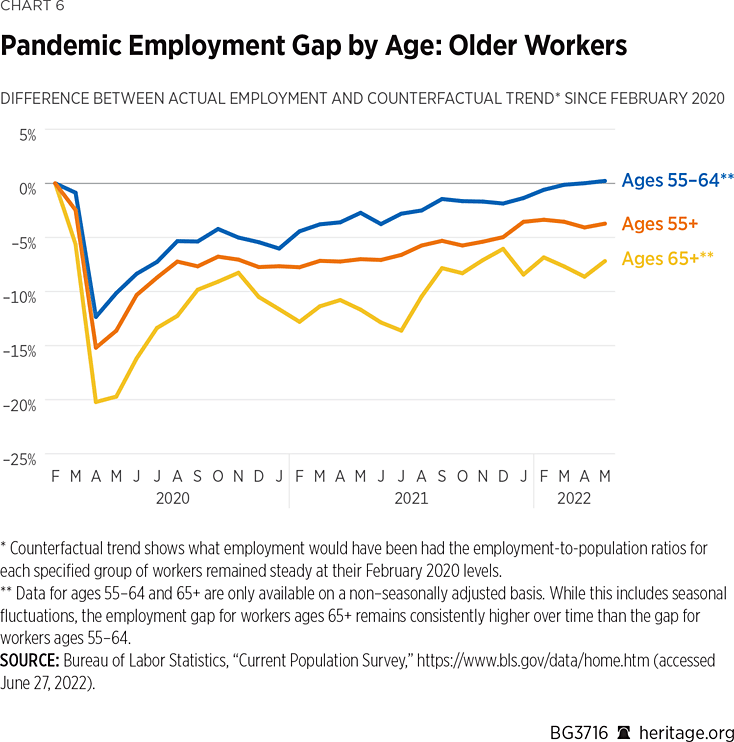
To help to encourage greater employment among older workers, policymakers should keep doors open for flexible and autonomous independent work (such as contracting, freelancing, and gig work) that can be particularly appealing to older workers who want to step back from full-time traditional employment but would still like to work. Legislation like the Protecting the Right to Organize Act (PRO Act)REF would hurt such opportunities by making it far more difficult for people to work independently, whereas the Employee Rights Act (ERA) would provide clarity and protections for individuals who want to be their own bosses.REF
Moreover, policymakers should consider eliminating Social Security’s retirement earnings test. This test, which takes away $1 in Social Security benefits for every $2 of earnings that an individual makes above $19,560 per year, is perceived as a 50 percent tax on work and thus causes older workersREF to work less than they otherwise would. Once individuals who were subject to the test reach their normal retirement age, their benefits are adjusted to effectively reimburse them for the benefits that had been withheld by the test—but most people do not realize this, and so they respond to the test by working and earning less. Eliminating the retirement earnings test would increase work, increase older workers’ incomes, increase federal income and Social Security tax revenues, and almost certainly increase economic growth.
Current Labor Shortages Are Not Caused by Childcare Struggles
Early in the pandemic, school and childcare closures significantly disrupted parents’—predominantly mothers’—ability to work. Moreover, pandemic-related concerns and restrictions in nursing homes and hospitals meant that more workers, predominantly women, were having to spend time caring for older family members. Yet, the data reveal that while these were significant concerns and struggles, they did not disproportionately affect women’s and parents’ employment (additional discussion on the reasons below under “Parents vs. Non-Parents”).
Table 2 provides a breakdown of the employment gaps for various groups of workers based on gender and presence and age of children, as measured by the percentage difference between current employment (May 2022) and where it would have been if, absent the pandemic, employment-to-population ratios had remained constant.REF
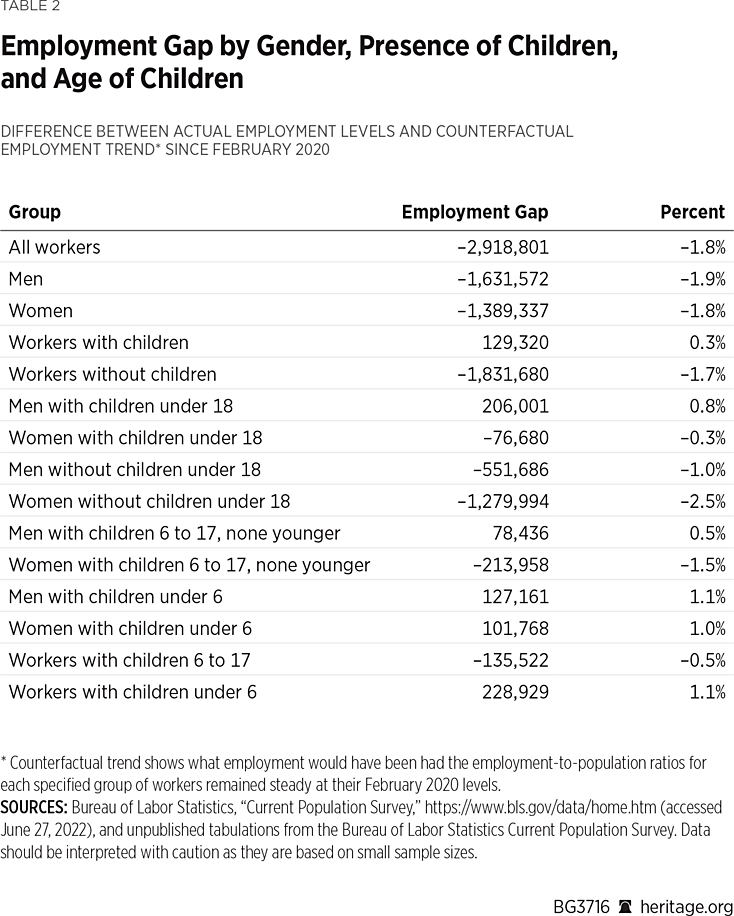
These data show that workers without children have the largest employment gaps. While the datasets are not identical, the age-based data displayed above suggest that the gaps among workers without children are almost certainly concentrated in young individuals ages 20 to 24 and older workers ages 65 and older.
Men vs. Women. Women’s employment gaps have often exceeded men’s throughout the pandemic, with a narrowing of those gaps in the spring of 2021, a widening in the summer and fall of 2021 and a recent narrowing throughout most of 2022. As of May 2022, women’s 1.8 percent employment gap is roughly on par with men’s 1.9 percent gap.
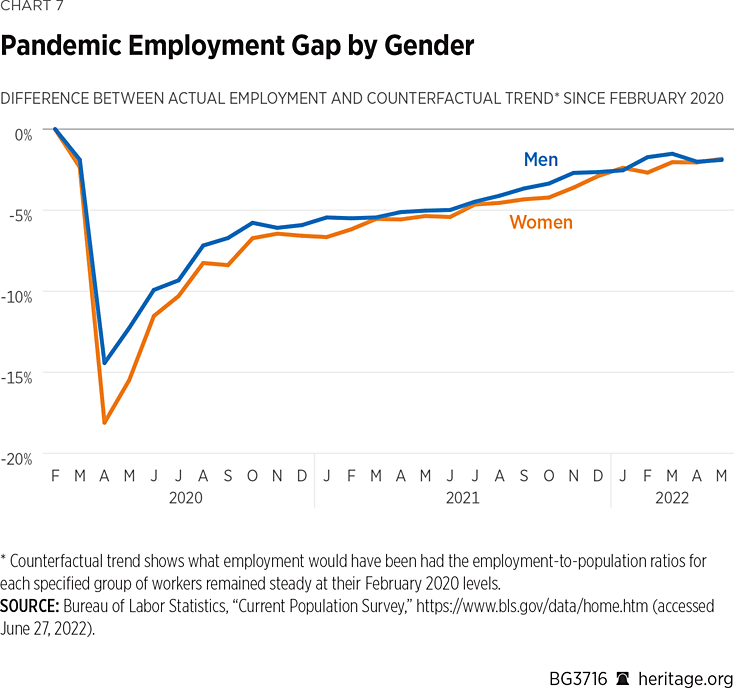
Parents vs. Non-Parents. Despite the narrative that parents’ employment was disproportionately harmed by school and childcare closures, the data do not reveal that to have been the case, as parents have consistently experienced smaller employment gaps than those without children. Currently, workers without children have a 1.7 percent employment gap while employment among workers with children has fully recovered and was 0.3 percent higher in May 2022 than it would have been had parents’ February 2020 employment-to-population ratio remained constant.
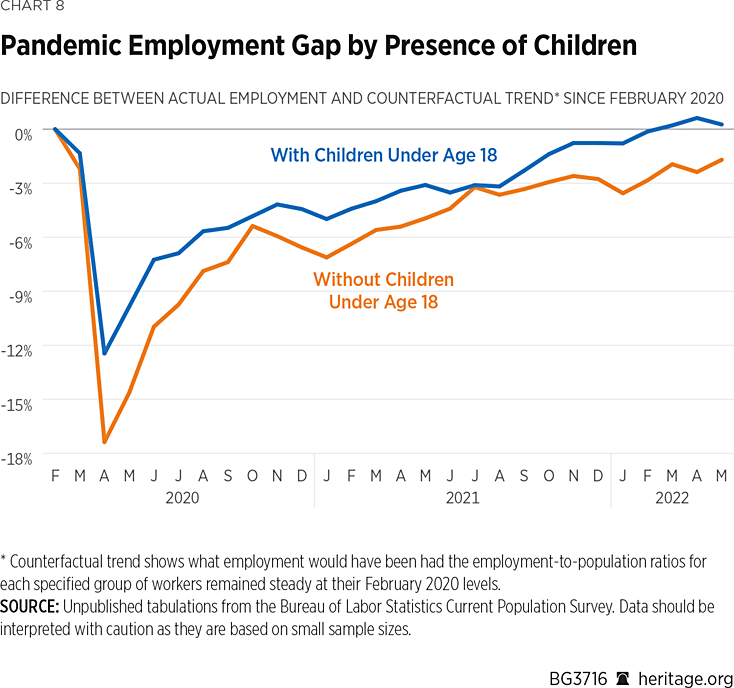
Multiple economic studies have shed light on this phenomenon. A study by Jason Furman (former Chair of President Obama’s Council of Economic Advisers), Melissa Kearney, and Wilson Powell III found that “despite the widespread challenges that parents across the country have faced from ongoing school and daycare closures, excess employment declines among parents of young children are not a driver of continuing low employment levels.”REF While childcare and school closures certainly created struggles, it appears that parents—especially mothers, muscled through those struggles. Claudia Goldin reported in a study that “the real story” is that “employed women…were stressed because they were in the labor force, not because they left.”REF
A breakdown of parents’ employment based on the age of the youngest child in their household suggests that childcare struggles may have had even less of a negative impact on parents’ employment than school closures.
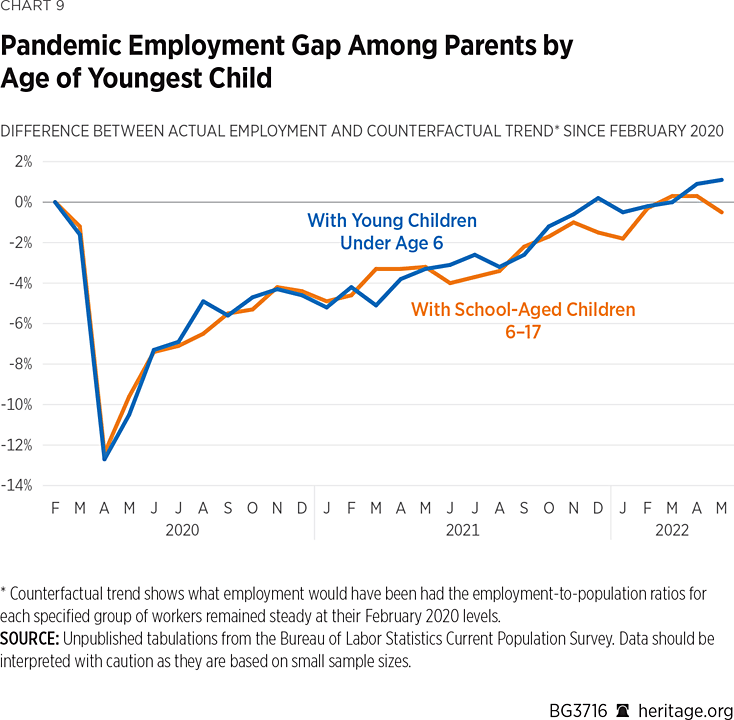
The employment gaps of parents whose youngest child is under six and of those whose youngest child is between ages six and 17 have been relatively similar, with parents of children under six experiencing a slightly lower employment gap, on average, throughout the pandemic. This may have been because childcare centers were less likely to close and more likely to reopen sooner than public schools where opposition from teachers’ unions resulted in longer and more widespread closures.
Differences in employment gap have existed between mothers and fathers, with mothers consistently experiencing larger employment gaps than fathers. As the breakdown by gender and age of youngest child in Chart 10 shows, as of May 2022, both men and women with children under age six have experienced full recoveries with an employment level 1.1 percent higher for women with children under age six than it would have been at their February 2020 employment-to-population ratio, and 1.0 percent higher for men with children under age six. Men with children ages six to 17 have also fully recovered as of May 2022, with a 0.5 percent increase in employment while women with children ages six to 17 are the only group to not have fully recovered, with a 1.5 percent employment gap.
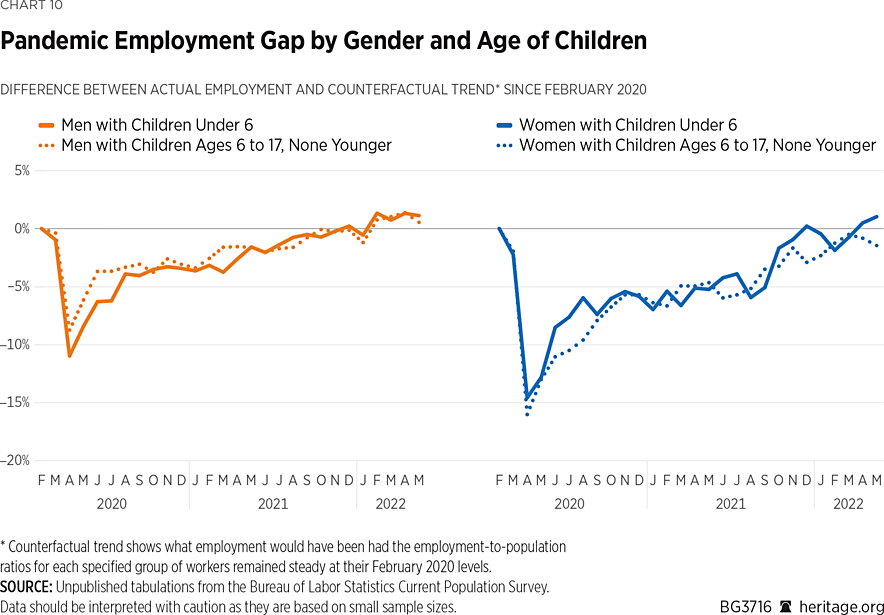
Parents’ consistently smaller employment gaps likely were affected, especially initially, by their tendency to have more seniority than younger, childless workers, and the fact that parents are less likely to work in lower-wage jobs, which experienced larger employment losses than higher-paying jobs at the start of the pandemic. Parents’ quicker recoveries likely have to do with the need to provide for their children creating a stronger desire for work that made them less likely to quit jobs and more likely to accept new jobs even when pandemic welfare programs may have provided significant income without work.
COVID-19 Impact
Health concerns about COVID-19 have certainly held some people back from employment, especially before the vaccines became widely available. However, the data show that COVID-19 is not a significant factor in current labor shortages.
In May 2020, the Bureau of Labor Statistics began collecting data related to the COVID-19 pandemic, including asking people who are not in the labor force if the reason they had not looked for work in the past four weeks was the coronavirus pandemic. This includes people who are scared of catching the virus, as well as other pandemic-related reasons, such as a business or childcare closing, or a change in personal or financial circumstances related to COVID-19.
In May 2020, 9.7 million people—5 percent of all people not in the labor force—said that they had not looked for work in the previous four weeks because of the coronavirus pandemic. That number has declined significantly, and as of May 2022, only 455,000 people—one of every 200 people not in the labor force—say that they are not looking for work because of the pandemic.
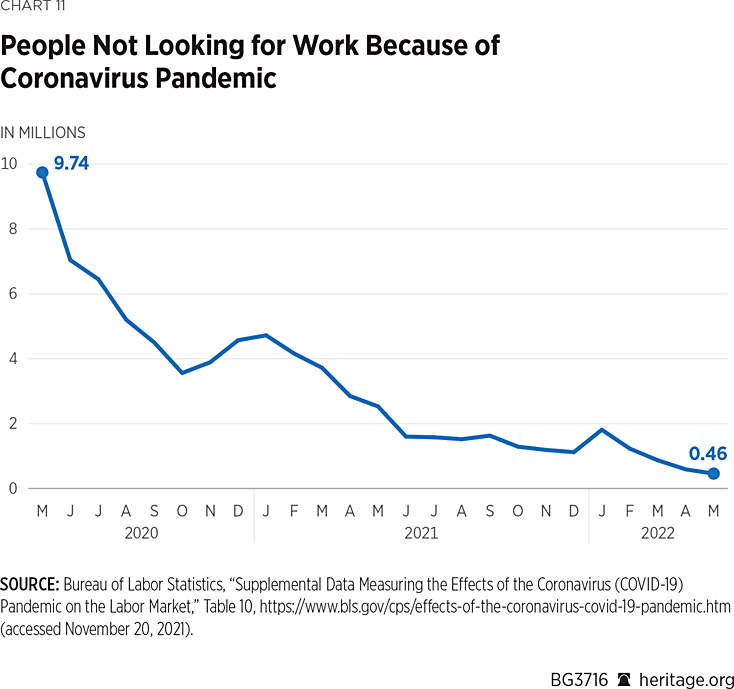
Vaccine Mandates. Various states, private businesses, and medical facilities began implementing COVID-19 vaccine mandates, or vaccine-and-testing mandates, in the late summer and fall of 2021. The Federal Reserve’s October 2021 “Beige Book” noted that vaccine mandates were contributing to high turnover and production slowdowns, and that impending “federal vaccine mandates were expected to exacerbate labor problems.”REF An October 2021 “Vaccine Monitor” survey from the Kaiser Family Foundation reported that 5 percent of adults said they would leave their job if their employer required them to get a vaccine or get tested weekly, and that figure jumped to 9 percent if weekly testing was not an option.REF
While some vaccine mandates have ended, the federal government’s Centers for Medicare and Medicaid Services’ (CMS’s) COVID-19 vaccine mandate still applies to roughly 14 million health care workers—which is almost certainly contributing to their outsized shortage. Employment growth in health care since vaccine mandates began around September 2021 has been less than half the rate of total employment growth. Had the health care sector experienced the same employment growth as the rest of the economy over the past eight months, there would be 263,000 more health care workers today.REF
Policies to Promote Stronger Employment, Better-Educated Workers
Labor shortages remain near record highs. While measures necessary to alleviate high inflation caused by excessive federal spending will likely lead to an economic slowdown or recession that will reduce demand and unfilled job openings, the need for and benefits of a well-functioning labor market are unchanging across time and economic conditions. Economic headwinds and the worsening U.S. fiscal outlook make the need for better education, labor, and tax policies especially urgent.REF
The demographics of current labor market gaps should be very telling for policymakers. The fact that employment gaps are concentrated in young workers and those over age 65 indicates that more education and income opportunities are the solutions. And the fact that parents’ employment has fully recovered indicates that a costly new federal childcare entitlement—particularly one that would drive up costs, limit supply, and disproportionately benefit high-income and already working families—would do little to increase employment and would add to inflation and federal budget woes.
When it comes to maximizing employment, policymakers need to abandon attempts to expand the government’s influence over people’s lives and instead look to how to expand individuals’ education and income opportunities by removing government-imposed barriers to work. Federal and state policymakers should:
- Expand apprenticeship programs by ending the government monopoly. A 2017 study by Harvard Business School and Burning Glass Technologies estimated that the number of occupations commonly filled through apprenticeships could nearly triple (from 27 to 74), that the number of job openings filled through apprenticeships could expand eight-fold (to 3.2 million), and that the occupations ripe for apprenticeship expansion could offer 20 percent higher wages than traditional apprenticeship occupations.REF Policymakers should pass the Training America’s Workforce Act, which would direct the U.S. Department of Labor to revive IRAPs so that Labor-approved entities, such as trade associations and educational institutions, could recognize and oversee apprenticeship programs.REF
- Replace failed federal job-training programs with more effective private and state or local programs. The federal government spends billions of dollars each year on job-training programs that fail to provide workers with education and experience that helps them to find and retain jobs. The Workforce Investment Act is supposed to provide training for in-demand services, but a gold-standard study found that only 32 percent of participants found occupations in their area of training and the majority—57 percent—did not believe that their training helped them to find employment.REF Moreover, an evaluation of the federal government’s primary youth job-training program found that a federal taxpayer investment of $25,000 per Job Corps participant resulted in participants being less likely to earn a high school diploma, no more likely to attend or complete college, and earning only $22 more per week.REF Instead of wasting taxpayer dollars and workers’ time on failed federal job-training programs, policymakers should allow workers to benefit from more effective employer-provided programs.REF
- Phase out federal subsidies for higher education to unleash more effective, lower-cost alternatives. Federal subsidies for higher education inflate total costs, drive up tuition, suppress more effective education alternatives, and have failed to expand lower-income Americans’ share of college graduates. The U.S. Department of Education should stop adding gasoline to the fire and allow private financial institutions to pick up any gap in new loans and financial aid.
- Prohibit blanket student-loan “forgiveness.” Congress should immediately prohibit the Biden Administration’s pending proposal for blanket student-loan forgiveness, which would be inflationary, morally hazardous, regressive, and tip the scales away from more effective education alternatives.
- Prevent tax increases. When employees and employers can keep more of what they earn, they will work more and put those higher incomes toward productive activities.REF
- Enable greater natural wage increases. Policymakers should eliminate double taxes on investments that boost productivity and wages.REF
- Protect independent work. Not everyone can work a traditional nine-to-five job, many people want to be their own bosses, and workplace flexibility is high on many people’s priorities. That is why one in three workers in the U.S. participates in independent work.REF The more control that people have over their work, the more work they perform.REF Congress should clarify the test for independent contractor status under the Fair Labor Standards Act, the National Labor Relations Act, and the tax code based on the “common law” test that determines how much control an employer exerts over a worker.
- Eliminate Social Security’s retirement earnings test. Social Security’s misunderstood earnings test is perceived by workers as a 50 percent tax on their earnings, which causes people to work less, and thus earn less, than they otherwise would. Policymakers should end this paternalistic and economically detrimental policy so that older Americans are not discouraged from working and earning more.
- Protect the franchising pathway to entrepreneurship. About 730,000 individually owned franchise operations employ 8.4 million workers across the U.S., but this successful small business model could be upended by the Biden Administration to redefine who is a “joint employer.” Congress should codify in law the long-standing precedent, and practical reality, that an individual’s employer is the one who hires, oversees, and pays her: the franchise owner.
- Prioritize workers’ choices about unionization. Congress should prioritize workers’ choices and respect unions’ resources by simultaneously eliminating forced unionization laws and “exclusive representation” laws (which require unions to represent non-union workers) so that workers do not have to pay for representation they do not want, and unions do not have to use their resources to represent workers who do not pay union dues.REF
- Enact the Employee Rights Act. This package of labor law modernizations, which incorporates many of the above recommendations, would help to expand employment by protecting existing and expanding work models, while respecting the rights of people to work in the ways that work best for them.REF
- Repeal the Davis–Bacon Actand end project labor agreement (PLA) requirements in federal construction projects. The Davis–Bacon Act purports to require federal construction contracts to pay the “prevailing wage,” but it does so through a non-scientific process that effectively sets inflated union wages as the prevailing wage.REF PLA requirements generally limit federal construction projects to unionized workers that represent only 14 percent of all construction workers. Congress should repeal these restrictions to allow more construction employment opportunities and to end the practice of penalizing workers and companies that choose self-representation instead of union representation.
- Expand accessible, affordable childcare. Childcare is critical for parents of young children who want or need to work, but it needs to be the type of care that parents want. The federal Head Start program for children from lower-income homes has lackluster outcomes and limited hours of operation, which means that it is often not a viable childcare solution for working parents.REF Congress should allow parents to use federal childcare subsidies and Head Start funds at a provider of their choice.REF
- Remove barriers to work flexibility. Congress should enact the Working Families Flexibility Act so that lower-wage workers can choose to accrue paid time off in exchange for overtime work and also remove an unintentional barrier in the Fair Labor Standards Act that makes it harder for businesses to offer childcare benefits.REF
- Make welfare work-oriented. President Bill Clinton quoted Robert Kennedy when he said: “Work is the meaning of what this country is all about. We need it as individuals, we need to sense it in our fellow citizens and we need it as a society and as a people.”REF Work is crucial to breaking cycles of poverty and dependence, which is why the primary goal of welfare should be to help individuals and families to thrive by empowering them, through work, to earn a living that allows them to make their own decisions and pursue their own goals. Welfare benefits for work-capable individuals must be tied to work.
- Reduce government spending so inflation does not make workers poorer. The surge in federal government spending over the past two years is undoubtedly fueling inflation, which has resulted in the average worker being $1,800 poorer despite high wage gains.REF The greater the returns to work, the more work that people will do. Congress must immediately reduce spending, starting first with ending recent spending expansions and followed by enacting entitlement reforms so that workers’ incomes do not continue to erode through inflation and the higher taxes needed to finance massive debt.
Conclusion
Work is fundamental to American society and to human flourishing. Adam Smith begins The Wealth of Nations by describing how the proportion of wealth, or “necessaries and conveniences,” that the people of a given nation enjoy must be determined, “first, by the skill, dexterity, and judgment with which its labour is generally applied; and, secondly, by the proportion between the number of those who are employed in useful labour, and that of those who are not so employed.”REF Policies that promote effective education, foster innovation, and encourage maximum employment are fundamental to societal and individual well-being.
The recent drop in work and labor force participation—particularly among young workers—is troubling. Today’s employment gap equals about 2.9 million workers, which is 1.8 percent of the workforce. Job openings, at 11.3 million, remain near record highs, and record percentages of employers report unfilled positions and compensation increases.
The current labor shortage is affecting the entire American economy, including business struggles, shortages of goods and services, disrupted supply chains, high and rising inflation, and rising deficits. Continued low levels of employment will reduce the rate of economic growth, reduce real incomes and output, result in greater dependence on government social programs, require higher levels of taxation, and exacerbate the U.S.’s already precarious fiscal situation.
Easing the labor shortage requires creating an environment in which more Americans want to pursue work and are able to maximize their productive capabilities. Reducing education and skills gaps requires expanding effective and low-cost or no-cost education options by reducing federal interventions in the higher education market and expanding apprenticeship options. The unintended consequences of many COVID-19 policies and federal interventions in the workforce demonstrate that while the temptation for policymakers is always to do more, the best way to increase employment is to remove the barriers that government has already created and to refrain from creating new or expanded regulations and programs that would discourage work.
Rachel Greszler is Senior Research Fellow for Economics, the Budget, and Entitlements in the Grover M. Hermann Center for the Federal Budget at The Heritage Foundation.



